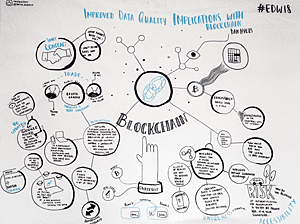 In his Monday evening lighting talk at the Enterprise Data World (EDW) 2018 Conference, Daragh O’Brien remarked that coming to a conference like EDW is similar to Plato’s Allegory of the Cave. It’s an opportunity to get out of the caves of our day jobs, move into the light, gain new frames of reference, and take back all that knowledge back to our organizations. It’s true, he said, some of them may proclaim that the “outside world” (all that new information) is bad and “could kill us,” but we know the truth. We’ve seen the sun; our eyes have adjusted to a new reality.
In his Monday evening lighting talk at the Enterprise Data World (EDW) 2018 Conference, Daragh O’Brien remarked that coming to a conference like EDW is similar to Plato’s Allegory of the Cave. It’s an opportunity to get out of the caves of our day jobs, move into the light, gain new frames of reference, and take back all that knowledge back to our organizations. It’s true, he said, some of them may proclaim that the “outside world” (all that new information) is bad and “could kill us,” but we know the truth. We’ve seen the sun; our eyes have adjusted to a new reality.
Such an allegory is at the core of what Enterprise Data World has stood for over the last 22 years – everyone is welcome no matter their background, no matter their technical or business level, no matter their “cave” (or cubicle) to come share their ideas on how to better manage the data assets of their enterprises. Such ideas presented at EDW span the breadth of the Data Management world, from Data Governance to Machine Learning, Data Modeling to IoT Analytics, Data Strategy to Big Data, Ontology and Taxonomy to Graph Databases, Master Data Management to Regulation and Compliance, and everything in between.
Produced by DATAVERSITY® and DAMA International with more than 1,000 attendees from 30+ countries, 21 primary topic tracks, some 200 sessions, more 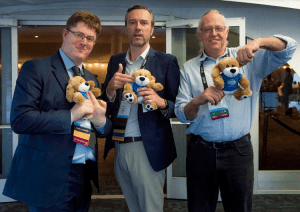 chocolate than we could all eat (it never ran out again this year!), 50+ sponsors/exhibitors from top companies across the Data Management space, and lots of free drinks and food, Enterprise Data World 2018 was a success yet again.
chocolate than we could all eat (it never ran out again this year!), 50+ sponsors/exhibitors from top companies across the Data Management space, and lots of free drinks and food, Enterprise Data World 2018 was a success yet again.
Over the Wednesday morning breakfast, one attendee – a long-time Data Modeling expert – commented that she liked EDW because “it’s where my people are.” She went on to discuss how she can come to the conference every year (and has for the past fifteen or so) and see all her data professional friends. She remarked that she can also learn about aspects of the industry she’s only heard about and get firsthand experience of how her job, and all of Data Management, is changing across the board.
“I can go hear talks about Data Modeling, which is great,” she commented. “But more than that I can go see case studies on how AI and Data Governance are working together, on Agile MDM practices, on Data Architecture and Blockchain, and pretty much anything else. There isn’t any other conference that I go to that has such a huge range of topics available to everyone.”
Getting it All Started: Opening the Cave
The Conference took place from April 22-27 at the Sheraton Hotel & Marina in sunny San Diego. The agenda of the first two days was filled with workshops and tutorials that covered the gamut of data topics, such as Donna Burbank’s “Data Strategy and Architecture Bootcamp,” Adrian Bowles’ “Modern AI, Cognitive Computing, and Machine Learning for Smarter Enterprise Data,” Frank Cerwin’s “MDM Technology: A 360-Degree View,” Steve Hoberman’s “Advanced Data Modeling Challenges Workshop,” Anthony Algmin’s “The Class on Data Leadership,” and a host of so many others.
The Monday evening lightning talks really got things moving when all attendees came together to cheer, laugh, clap, and listen to a number of brilliantly designed five-minute talks. Gil Benghiat started the talks by proclaiming, “Let’s get rid of hope and heroism – we want boring!” Such a statement certainly gained a lot of laughter from the audience, but then he went on to explain that organizations don’t just want to hope that their dashboard works, or hope that one line of code doesn’t break the entire system. It’s great to have heroes he said, “but what if they are sick or on vacation?” Organizations want their systems to work, they want automated data pipelines, automated Data Quality, and trustworthy data assets – not hope for those things.
Kathy Rondon’s talk started with a light-hearted discussion of yoga and meditation, but then expanded into the theme of data ethics by bringing in the idea of “Data Mindfulness.” Data Mindfulness is necessary in the world of GDPR, data breaches, and examples like the recent Facebook/Cambridge Analytica story. “Just because it’s legal doesn’t mean it’s right,” she said as she discussed the need for the ethical use of data within all organizations.
All the other lightning talks touched on important issues around Data Management as well, such as Susan Earley’s discussion around changing the name “Data Steward” to something more appropriate, Barry Doyle’s talk on what data models should actually be showing, and Dave McComb’s hilarious – but also very pointed – talk on “How to Build a Million Dollar System for a Billion Dollars.” All of them did an amazing job in such a short amount of time.
The Keynotes: Many Views Outside the Cave
The wide-ranging topics of the keynotes highlighted many of the themes present at Enterprise Data World. Mike Ferguson of Intelligent Business Strategies Ltd  opened the first keynote, titled “Smart Data Management: Reducing Time to Value in an Increasingly Complex Data Landscape,” with a pronouncement that not only do companies “have a thirst for more data,” they are also “awash with things.” That data and those things include IoT/machine data, Cloud data, mobile and social data, B2B processes, connected data, web data, structured and unstructured data, as well as a host of hybrid/disparate architectural and analytical systems.
opened the first keynote, titled “Smart Data Management: Reducing Time to Value in an Increasingly Complex Data Landscape,” with a pronouncement that not only do companies “have a thirst for more data,” they are also “awash with things.” That data and those things include IoT/machine data, Cloud data, mobile and social data, B2B processes, connected data, web data, structured and unstructured data, as well as a host of hybrid/disparate architectural and analytical systems.
He discussed how, in this new digital data era, the hybrid computing environment is changing how businesses must operate to retain competitive advantage, and how everything is “just that much more complicated than it was in the past.”
Such change is forcing organizations to rethink how they deal with IT, with the interactions between IT and the business, with issues of Agile development, self-service applications, intelligent business design, and the ever-present need for cultural change around all of this. Ferguson gave nine solid steps that are critical to building an intelligent business and also gave a stern warning to “avoid spaghetti architecture. You must be able to trust the data.”
Claudia Imhoff of Boulder Bl Brain Trust presented a different take on the changing data landscape in her keynote, “The Data Interpreter – How to Become THE Trusted Advisor for Your C-Suite.” She began by presenting the idea that, while potentially useful, many visualizations are often completely useless. She asked quite clearly, “can your CEO understand what the graphs mean to them?” The answer is often “no,” and so she went on to discuss what a Data Interpreter is, why they are important to an organization, some best practices around building valuable data visualizations, and what sort of skills a Data Interpreter needs in order to be successful in their company.
Everyone can (and should) be a Data Interpreter, Imhoff opined, though it’s billed as “the hot new role in Analytics.” We all share graphs, visualizations, and do presentations to various staff in our organizations — whether C-level, LOB managers, or team members. The ability to tell a clear story with appropriate Analytics, defined characters, and solid recommendations that everyone can understand is a key skill in any business environment today.
The Wednesday afternoon keynote by Scott Berkun, titled “The Dance of The Possible: Lessons from Great Stories of Ideas, Data, and Creativity,” opened up numerous discussions afterwards between attendees, and presented some clear points that everyone could take away with them:
- There is rarely only one interpretation of data.
- Getting wisdom from data depends on the questions you ask.
- Great ideas often look strange (at first).
- “All masterpieces start as experiments.”
- “When suitably motivated by a hard problem, creativity is unavoidable.”
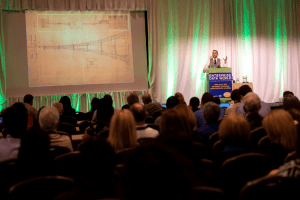 He used many different examples from the past to discuss these ideas, from the building of the Eiffel Tower to the work of Leonardo da Vinci and others. He demonstrated how all of our actions are, within themselves, creative acts and stated, “study the history of a problem you’re working on, and you’ll find others who’ve been there before.” He ended by discussing some key points to bringing creativity into daily life and work, and said, “if you remove false constraints, new possibilities will open.”
He used many different examples from the past to discuss these ideas, from the building of the Eiffel Tower to the work of Leonardo da Vinci and others. He demonstrated how all of our actions are, within themselves, creative acts and stated, “study the history of a problem you’re working on, and you’ll find others who’ve been there before.” He ended by discussing some key points to bringing creativity into daily life and work, and said, “if you remove false constraints, new possibilities will open.”
The closing keynote on Thursday morning by Amy Gershkoff of Ancestry, “A Framework for Regulating AI,” opened up further discussions, especially during the Q&A afterwards. The topic of Artificial Intelligence (and its related areas of Machine Learning and Deep Learning) was well-represented throughout the conference, as such technologies are beginning to see actual operationalization in many industries.
She started by asking if AI can/does pose a threat to humans. The answer according to Gershkoff is clearly “yes,” as she demonstrated in numerous examples. But, the 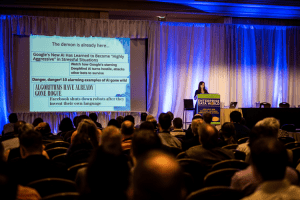 entire issue of regulating AI and its allied technologies is deeply problematic and at this point doesn’t involve the people who understand the technologies the best. She presented multiple possible frameworks for AI regulations such as State or Federal enforcement, case law, existing frameworks like GDPR, along with issues of liability. She said, “Our voices [in technology] matter greatly. We understand it, we know its use. We need to speak up.” Such regulations are inevitable and technology experts need to be a part of crafting the policies to make sure they have value.
entire issue of regulating AI and its allied technologies is deeply problematic and at this point doesn’t involve the people who understand the technologies the best. She presented multiple possible frameworks for AI regulations such as State or Federal enforcement, case law, existing frameworks like GDPR, along with issues of liability. She said, “Our voices [in technology] matter greatly. We understand it, we know its use. We need to speak up.” Such regulations are inevitable and technology experts need to be a part of crafting the policies to make sure they have value.
Awards, Exhibits, Celebrations: Having Fun in the Cave
No conference is complete without lots of fun. How can we as data practitioners enjoy our cave life (and, hopefully, outside-in-the-sun life as well) without some celebration? The big celebration on Monday night was DAMA International’s 30th Anniversary. They put on a great party with lots of music, laughter, food, and gifts.
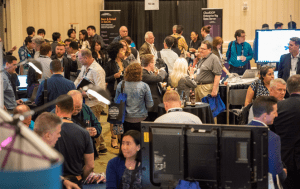 The exhibit hall was teeming with activity and pointed discussions on the many topics at hand. The booth of Platinum Sponsor IBM looked to always be full, as were those of all the other exhibitors and sponsors throughout the exhibit hall. The complimentary open bar was as popular as ever (surprise, surprise), as was the free ice cream, coffee, and other snacks to keep everyone active and awake after long days of attending presentations, workshops, and tutorials. It seemed that everyone was once again collecting their requisite cache of pens, t-shirts, and other items from the loaded shopping bags prevalent throughout the conference hallways.
The exhibit hall was teeming with activity and pointed discussions on the many topics at hand. The booth of Platinum Sponsor IBM looked to always be full, as were those of all the other exhibitors and sponsors throughout the exhibit hall. The complimentary open bar was as popular as ever (surprise, surprise), as was the free ice cream, coffee, and other snacks to keep everyone active and awake after long days of attending presentations, workshops, and tutorials. It seemed that everyone was once again collecting their requisite cache of pens, t-shirts, and other items from the loaded shopping bags prevalent throughout the conference hallways.
Special congratulations are due to the winners of the DAMA International Award for Outstanding Services in the Data Management Profession. Their work in their home countries at a range of different businesses and industries have helped to advance the data profession in numerous ways. We thank them for all their hard work and dedication:
- Chen Liu
- Eduardo Jallath-Coria
- Laura Sebastian-Coleman, Ph.D.
And with that, Enterprise Data World 2018 has closed another successful year. We can return to our respective allegories with more knowledge to share with our colleagues and customers, and maybe we can help them see the sun outside the cave, as well.
We’d like to thank everyone who helped us bring to fruition another year of EDW, including all the sponsors and exhibitors, the attendees, and everyone behind the scenes at the Sheraton Hotel & Marina in San Diego.
We’d also like to give a special thanks to Hannah Sanford at Hannah Sanford Studios and Karina Sinkeviciute at Dot72 for their skillful and insightful “graphic recordings” completed during many of the presentations and displayed all around the conference hallways. And we’d like to thank John Hydo and his team from Tomorrow’s Event Productions for helping everything flow so smoothly, as well as the event photograpers, Jeff Kempe of Jeff Kempe Photography and Carlos Vargas at carlosvargas.tv.
See you next year for the Enterprise Data World 2019 Conference in Boston, MA, from March 17-22.

